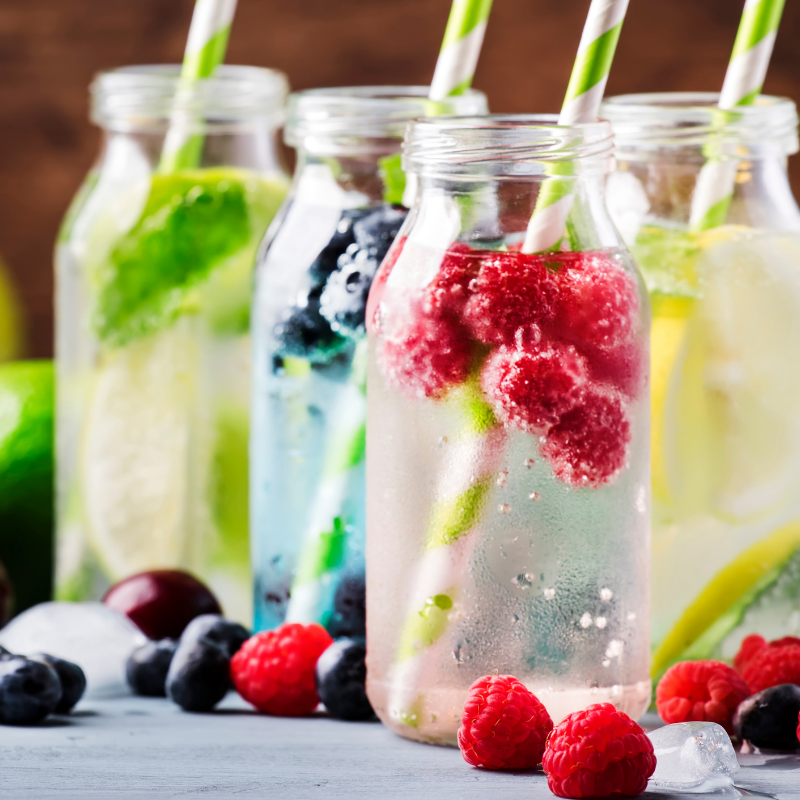What You Need to Know to Lose Lots of Weight, Avoid or Control Diabetes and Lower the Risks of Heart Disease and Even Cancer
You are probably aware of the alarming percentage of Americans that are overweight or even obese. In no small way, the amounts of sugar that have crept into our diets from sources like sugary beverages, cereals and desserts, have not only rendered us over-weight but under-healthy with type 2 diabetes and insulin resistance increasing like never before.
Articles and dieticians often speak about the blood sugar raising ability of the different kinds of carbohydrates in various foods that we may choose to eat. Carbohydrates can be simple sugars like sucrose (which is a combination of glucose and fructose) or fructose (which is the sugar found in fruits that has its own set of issues) or complex carbohydrates like starches (which are just long chains of glucose attached to one another) and finally dietary fiber (which is indigestible by our bodies, so, therefore, does not raise blood sugar).
Glycemic Index
The term that helps us to understand how much carbohydrates are in foods and raise blood sugar, is called “glycemic index”, (GI). GI is calculated by taking 50 grams of a specific carbohydrate found in a food and measuring how much it raises blood sugar compared to 50 grams of pure glucose.
So for example, if the glycemic index of a carbohydrate in carrots was 78 this would mean that 50 grams of it raised blood sugar, 78% of how much the same amount of glucose raised blood sugar.
Foods with a GI below 55 are considered low GI foods. GI’s between 55-70 are considered intermediate GI foods and foods with a GI above 70 are considered high GI foods.
This is important information, but you need to know and understand that sometimes even the best of intentions can go awry.
By this I mean, knowing the GI of a particular food is only part of the story. This is because “quantity counts”! You will recall that I mentioned above that GI is calculated by comparing how much an equal amount of a carbohydrate in a food (50grams) raises blood sugar compared to 50 grams of glucose.
The GI of any particular carbohydrate found in a given food is a number that is a percentage relative to glucose. What it doesn’t tell us, is how much of the carbohydrate is actually in a given-sized serving of the food.
What we really want to know and monitor in order to lose weight and avoid diabetes or insulin resistance and the diseases like obesity, heart disease, and cancer, they can lead to, is the absolute, real-life amount of increase in blood sugar, eating a specific sized portion of a given food will cause. Not its relative percentage compared to 50 grams of glucose.
Percentages can be very deceiving. I could say that I save 30% of my income. This is an impressive percentage but if I earn $10,000 a year, it is $3,000.
On the other hand, I could save only 10% of my income but if I earn $100,000, the savings is $10,000, more than 3 times greater in absolute dollars.
Well, the same thing applies to GI, it is a percentage, it does not tell you the absolute increase in blood sugar a given sized portion of a specific food will cause. It doesn’t do this because it doesn’t take into consideration the absolute amount of the carbohydrate, actually found in the food.
This is where the concept of glycemic load comes in. (GL) Knowing and monitoring the GL, which you can get from charts on the internet and one sample is provided below, of the foods you eat will get you far down the path to a much slimmer and healthier you.
The GL of a food is calculated from its GI times the actual amount by weight of the carbohydrate that is present in a given sized portion divided by 100.
Think about it, if a food has a glycemic index of 20 that is very low! 50 grams of it only raises blood sugar by 20% of what an equal weight of glucose raised blood sugar. What if the weights are not equal?
What if you eat 5 times the amount by weight of that food, so instead of 50 grams, which is the weight used to calculate GI, you eat 250 grams (a little more than ½ of a pound)? Well then your blood sugar would raise the same amount as eating 50 grams of glucose because 5X20= 100.
Glycemic load gives you real-life, very valuable blood sugar information about the size of the portions of each food you choose. It enables you to limit portion sizes so that you control blood sugar and really establish a powerful regimen under which you can lose substantial amounts of weight while avoiding diabetes, heart disease, cancer, and many other chronic diseases.
Avoiding the effects of too much sugar in the body is very anti-aging as well. Both your internal organs and your skin will benefit tremendously.
Below is a sample chart of the glycemic load of certain foods. Additional charts can be found on the internet just Google glycemic load.
I advise you to try to average no higher than 50 in your GL food choices. So if you choose to splurge and eat a dessert with a GL of 80 try to offset it with an equal number of calories of a food with a 20 GL while keeping your total calories in the 2000 calorie per day range if you are a woman of average physical activity. (As low as 1500 for faster weight loss) For men, the caloric intake, depending upon muscle mass and physical activity should probably be in the 2400-2800 calorie per day range. (Around 1800-2000 for faster weight loss)
|
FOOD LIST |
RATING |
FOOD GLYCEMIC INDEX |
|
BAKERY PRODUCTS |
||
|
*Poundcake |
Low |
54 |
|
Danish pastry |
Medium |
59 |
|
Muffin (unsweetened) |
Medium |
62 |
|
Cake, tart |
Medium |
65 |
|
Cake, angel |
Medium |
67 |
|
Croissant |
Medium |
67 |
|
Waffles |
High |
76 |
|
Doughnut |
High |
76 |
|
BEVERAGES |
||
|
Soya milk |
Low |
30 |
|
Apple juice |
Low |
41 |
|
Carrot juice |
Low |
45 |
|
Pineapple juice |
Low |
46 |
|
Grapefruit juice |
Low |
48 |
|
Orange juice |
Low |
52 |
|
BISCUITS |
||
|
Digestives |
Medium |
58 |
|
Shortbread |
Medium |
64 |
|
Water biscuits |
Medium |
65 |
|
Ryvita |
Medium |
67 |
|
Wafer biscuits |
High |
77 |
|
**Rice cakes |
High |
77 |
|
BREADS |
||
|
Multigrain bread |
Low |
48 |
|
Whole grain |
Low |
50 |
|
Pita bread, white |
Medium |
57 |
|
Pizza, cheese |
Medium |
60 |
|
Hamburger bun |
Medium |
61 |
|
Rye-flour bread |
Medium |
64 |
|
Wholemeal bread |
Medium |
69 |
|
White bread |
High |
71 |
|
White rolls |
High |
73 |
|
Baguette |
High |
95 |
|
BREAKFAST CEREAL |
||
|
All-Bran |
Low |
42 |
|
Porridge, non-instant |
Low |
49 |
|
Oat bran |
Medium |
55 |
|
Muesli |
Medium |
56 |
|
Mini Wheats (wholemeal) |
Medium |
57 |
|
Shredded Wheat |
Medium |
69 |
|
Golden Grahams |
High |
71 |
|
Puffed wheat |
High |
74 |
|
Weetabix |
High |
77 |
|
Rice Krispies |
High |
82 |
|
Cornflakes |
High |
83 |
|
CEREAL GRAINS |
||
|
Pearl barley |
Low |
25 |
|
Rye |
Low |
34 |
|
Wheat kernels |
Low |
41 |
|
Rice, instant |
Low |
46 |
|
Rice, parboiled |
Low |
48 |
|
Barley, cracked |
Low |
50 |
|
Rice, brown |
Medium |
55 |
|
Rice, wild |
Medium |
57 |
|
Rice, white |
Medium |
58 |
|
Barley, flakes |
Medium |
66 |
|
Taco Shell |
Medium |
68 |
|
Millet |
High |
71 |
|
DAIRY FOODS |
||
|
Yogurt low-fat (sweetened) |
Low |
14 |
|
Milk, chocolate |
Low |
24 |
|
Milk, whole |
Low |
27 |
|
Milk, Fat-free |
Low |
32 |
|
Milk , skimmed |
Low |
32 |
|
Milk, semi-skimmed |
Low |
34 |
|
*Ice-cream (low-fat) |
Low |
50 |
|
*Ice-cream |
Medium |
61 |
|
FRUITS |
||
|
Cherries |
Low |
22 |
|
Grapefruit |
Low |
25 |
|
Apricots (dried) |
Low |
31 |
|
Apples |
Low |
38 |
|
Pears |
Low |
38 |
|
Plums |
Low |
39 |
|
Peaches |
Low |
42 |
|
Oranges |
Low |
44 |
|
Grapes |
Low |
46 |
|
Kiwi fruit |
Low |
53 |
|
Bananas |
Low |
54 |
|
Fruit cocktail |
Medium |
55 |
|
Mangoes |
Medium |
56 |
|
Apricots |
Medium |
57 |
|
Apricots (tinned in syrup) |
Medium |
64 |
|
Raisins |
Medium |
64 |
|
Pineapple |
Medium |
66 |
|
**Watermelon |
High |
72 |
|
PASTA |
||
|
Spaghetti, protein-enriched |
Low |
27 |
|
Fettuccine |
Low |
32 |
|
Vermicelli |
Low |
35 |
|
Spaghetti, whole wheat |
Low |
37 |
|
Ravioli, meat filled |
Low |
39 |
|
Spaghetti, white |
Low |
41 |
|
Macaroni |
Low |
45 |
|
Spaghetti, durum wheat |
Medium |
55 |
|
Macaroni cheese |
Medium |
64 |
|
High |
92 |
|
|
ROOT CROP |
||
|
Carrots, cooked |
Low |
39 |
|
Yam |
Low |
51 |
|
Sweet potato |
Low |
54 |
|
Potato, boiled |
Medium |
56 |
|
Potato, new |
Medium |
57 |
|
Potato, tinned |
Medium |
61 |
|
Beetroot |
Medium |
64 |
|
Potato, steamed |
Medium |
65 |
|
Potato, mashed |
Medium |
70 |
|
Chips |
High |
75 |
|
Potato, microwaved |
High |
82 |
|
Potato, instant |
High |
83 |
|
**Potato, baked |
High |
85 |
|
Parsnips |
High |
97 |
|
SNACK FOOD & SWEETS |
||
|
Peanuts |
Low |
15 |
|
*M&Ms (peanut) |
Low |
32 |
|
*Snickers bar |
Low |
40 |
|
*Chocolate bar; 30g |
Low |
49 |
|
Jams and marmalades |
Low |
49 |
|
*Crisps |
Low |
54 |
|
Popcorn |
Medium |
55 |
|
Mars bar |
Medium |
64 |
|
*Table sugar (sucrose) |
Medium |
65 |
|
Corn chips |
High |
74 |
|
Jelly beans |
High |
80 |
|
Pretzels |
High |
81 |
|
Dates |
High |
103 |
|
SOUPS |
||
|
Tomato soup, tinned |
Low |
38 |
|
Lentil soup, tinned |
Low |
44 |
|
Black bean soup, tinned |
Medium |
64 |
|
Green pea soup, tinned |
Medium |
66 |
|
VEGETABLES & BEANS |
||
|
Artichoke |
Low |
15 |
|
Asparagus |
Low |
15 |
|
Broccoli |
Low |
15 |
|
Cauliflower |
Low |
15 |
|
Celery |
Low |
15 |
|
Cucumber |
Low |
15 |
|
Eggplant |
Low |
15 |
|
Green beans |
Low |
15 |
|
Lettuce, all varieties |
Low |
15 |
|
Low-fat yogurt, artificially sweetened |
Low |
15 |
|
Peppers, all varieties |
Low |
15 |
|
Snow peas |
Low |
15 |
|
Spinach |
Low |
15 |
|
Young summer squash |
Low |
15 |
|
Tomatoes |
Low |
15 |
|
Zucchini |
Low |
15 |
|
Soya beans, boiled |
Low |
16 |
|
Peas, dried |
Low |
22 |
|
Kidney beans, boiled |
Low |
29 |
|
Lentils green, boiled |
Low |
29 |
|
Chickpeas |
Low |
33 |
|
Haricot beans, boiled |
Low |
38 |
|
Black-eyed beans |
Low |
41 |
|
Chickpeas, tinned |
Low |
42 |
|
Baked beans, tinned |
Low |
48 |
|
Kidney beans, tinned |
Low |
52 |
|
Lentils green, tinned |
Low |
52 |
|
Broad beans |
High |
79 |
*High in empty calories **Low-calorie and nutritious foods
Making small adjustments to your daily eating habits can reap large rewards including increasing your lifespan.
To the best of health,
Curt Hendrix, M.S., C.C.N., C.N.S.


